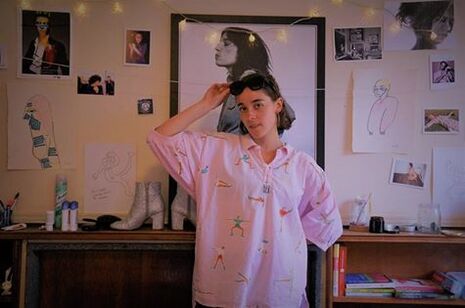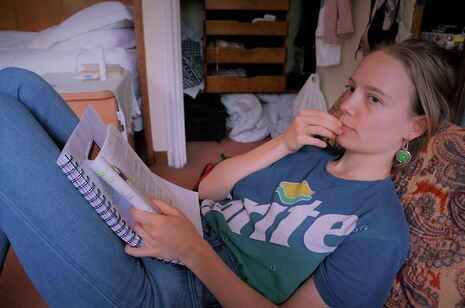In defence of Bunny
“The essence of Bunny is a suggestion that all social problems are connected. Broader problems are present in the play, and you’re right: we toned them down”. Director Carina Harford responds to Katy Nelson’s appraisal of Bunny

As the director of Bunny, I am writing in response to the article on the “rampant classism” of the play. As Katy Nelson says, two of the main issues touched upon by the play are race and class. Again, as she says, these issues are seen solely through Katie’s eyes and can therefore seem somewhat ‘lesser’ in the narrative than her ‘personal’ dilemmas, which entail issues of consent, social difficulties and what she sees as academic failure. This contrast is an intentional feature of the play.
Katie’s life is permeated with these difficult aspects of social politics, but to her, and to many people, including those in what you term the “middle-class bracket” at Cambridge, these problems can feel as important as their ‘personal problems’.
In fact, you could go mad and consider that this balance between the personal and political is one that is ripe for artistic expression, that this is a common area of theatrical interest, and that it is a concern in everyone’s lives: e.g. my next door neighbour is racist, but my daughter scratched ‘cunt’ onto the side of my car and I need to deal with that. It is this balance between wider social problems and the individual growing pains of adolescence (and life in general) that makes the play so poignant and, in some ways, so ‘relatable’.
The essence of Bunny is a suggestion that all social problems are connected. Broader problems are present in the play, and you’re right: we toned them down. We did this because they are toned down to Katie, because they are toned down to many people, and because it is this subtlety that conveys the sinister nature of prejudice - it is pervasive. It trickles down from Asif’s notion of “terrorists” to Katie’s difficulty in describing her boyfriend as “black”.
The original article asked for “more acknowledgement”, so here it is. To address its points chronologically:
First, Katie is not necessarily working class. All the information provided about her would suggest that she, in fact, is middle class. She plays the clarinet in her school orchestra, which her parents think is important, she scratches her “dad’s car”, suggesting that the family owns two cars, her house can accommodate a party for 25 of her friends, and therefore would seem to be relatively sizeable.
“The essence of Bunny is a suggestion that all social problems are connected. Broader problems are present in the play, and you’re right: we toned them down”
Perhaps we have differing definitions of working and middle class, but to me, Katie’s father speaking multiple foreign languages for work and reading The Guardian would not place her family within the traditional boundaries of the British working class.
Poverty is not used as a source of humour. As the article quotes, Katie’s shoplifting is a “phase,” i.e, she does not shoplift for survival, but compulsively as manifestation of a psychological problem. This is a common phenomenon. Yes, stealing for some is unfortunately a necessary reality, but for others it can be a mental crutch, based not on financial lack, but on other social and psychological pressures.
The audience was not laughing at the mere notion of shoplifting, but at the idea that Katie, aged, according to her, 14 or 15 years old, was stealing cleaning equipment that she didn’t use (with further subtext being that as a middle-class girl, she was not involved in housekeeping in any meaningful way, and therefore the fruits of her theft were truly useless).
To continue on the subject of Katie’s patronising presentation as a working-class woman, it is the original article which suggests that her intelligence is an anomaly, not the play. She is sincerely presented as an intelligent young person, with that intelligence being unrelated to whichever class you decide to bracket her into. Furthermore, the most academically successful person in the play is Iqbal, who, despite living on the “shit estate” that is Marsh Farm, has been accepted to both Oxford and LSE, while Katie, who is in a distinctly more privileged position that Iqbal, has been rejected by four out of the five Universities she applied to.
Also, the phrase “good word”, applied after the use of a ‘good word’ is not suggesting a lack of intelligence nor is it a heavy-handed illustration of her intelligence, but rather plays with the fourth wall, and shows that Katie is someone who is acutely aware of her own use of language. Note the moment where she realises that ‘interpretation’ was the wrong word for the setting she is in, or where she comments that Abe means “blood sugar” but is refusing to engage with what he considers to be high-register terminology.

It is an amusing nod to her self-awareness, not an undermining of her or her class, which as discussed above, I believe the article has misinterpreted. Also, the most famous user of “good word”, would probably be Miranda Hart, who is by no means working class, or using the phrase to do anything other than enjoy an unusually phonetically pleasing or under-appreciated word.
Next, crime is not normalised by the play. Crime is normalised by its very existence. It is normal because it is a common occurrence, and to deny the levels of crime are higher in certain areas is to deny fact. The fact that crime is on average higher in lower-income areas is indicative of an unfortunate social situation that needs to be rectified, but Katie making light of the situation is not equivocal to the normalisation of crime. Fights happen. Katie watches. She is interested, yet, by the end, while desiring violence on one level, she decides to choose ‘suspense’, to free Iqbal and rise above the immediacy of bloodshed.
“Katie, like all of us, is coming of age in a country where race and class are unsolved social issues”
Katie’s joke is funny because it amusingly relates an aspect of truth. She is saying that in times of social chaos (‘civil war’), those who are weaponised are in power, and that those people are most likely not who the public would have elected to hold that power. This is largely true. It’s how wars work. That’s also how jokes work.
Then we reach racial tensions. I cannot tell if you are upset by the use of fictional, reported speech racial slurs, but if you are, perhaps consider the nature of the theatre, and then the current state of our country. Racism is real, and many people hold what we would term racist views. We cannot censor these people out of existence; pretending they do not exist is not the answer.
Following this, you point out that the play over-simplifies racial issues. Yes, because it’s a monologue written from the point of view of a girl who describes race as a “conundrum”. It is intentionally naive. It is emphasising that naivety, asking us what will happen to Katie, and all of us who in some way identify with her, if we do not address these problems. This is the point of the unreliable narrator. This is the point of characters, of fiction, of theatre.
You insist that racial stereotyping is a problem in the play, when in actuality, the play invokes no overt racial stereotypes. Asif, an Asian man, is the most dominant and sexually assertive figure in the play, when the prevailing “asian male stereotype” is a figure lacking dominance and sexual prowess.
Abe is a particularly nuanced character in his shyness and inconsistent posturing, and Iqbal is a brave, intelligent and presumably hard-working figure, whose character is not formed by his race. The most stereotypical character in the play is perhaps Jake, a young white man, who by all descriptions is the dim-witted thug, a stock character used for nothing but laughs.
And yes, the play is a coming of age tale, regardless of its setting or wider social concerns - it is a play about a girl going on a journey, both internal and external, and making an important choice. Classic Bildungsroman, if you will. Katie, like all of us, is coming of age in a country where race and class are unsolved social issues. No one is growing up in a vacuum, everything is part of the adolescent (and lifelong) mess.
Bunny is about class, race, sexuality, gender and more, but the discussion of these issues through an imperfect lens is a discussion that opens the work to an audience with the feeling that it is accessible, that it proffers no perfect answer and no exacting terminology.
This does not make the work classist, or racist, or misogynistic, or promotional of rape culture or anything else. It makes it a piece of theatre which is designed to highlight these issues. Katie is the vehicle of our own ignorance, and the play is a stark depiction of the ramifications of that ignorance
 News / Cambridge academics stand out in King’s 2026 Honours List2 January 2026
News / Cambridge academics stand out in King’s 2026 Honours List2 January 2026 Interviews / You don’t need to peak at Cambridge, says Robin Harding31 December 2025
Interviews / You don’t need to peak at Cambridge, says Robin Harding31 December 2025 Comment / What happened to men at Cambridge?31 December 2025
Comment / What happened to men at Cambridge?31 December 2025 News / Varsity’s biggest stories of 202531 December 2025
News / Varsity’s biggest stories of 202531 December 2025 Features / “It’s a momentary expression of rage”: reforming democracy from Cambridge4 January 2026
Features / “It’s a momentary expression of rage”: reforming democracy from Cambridge4 January 2026









